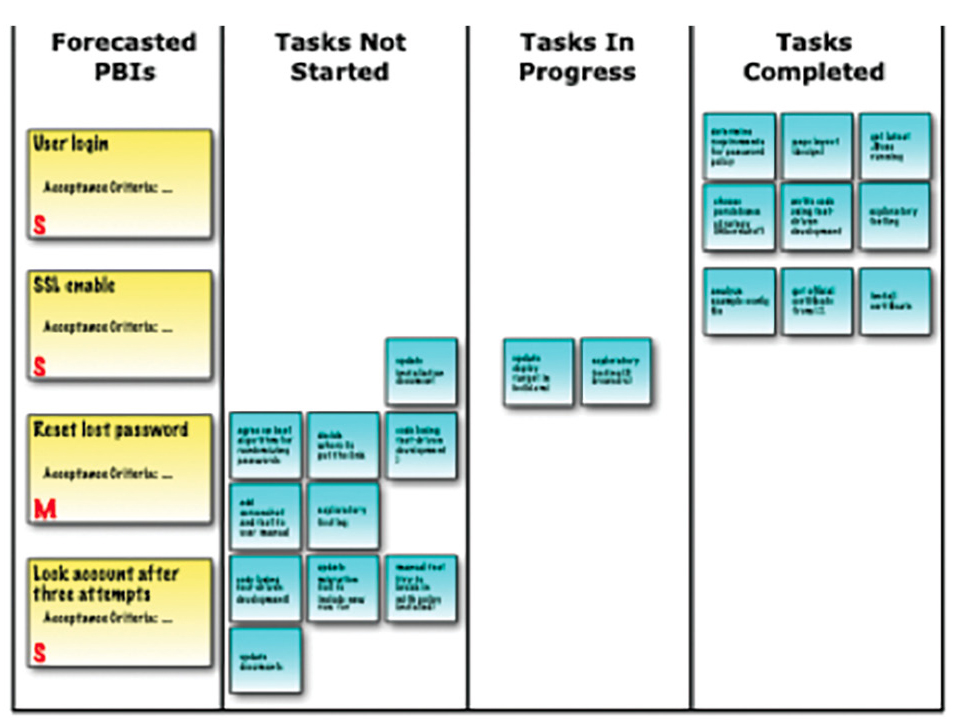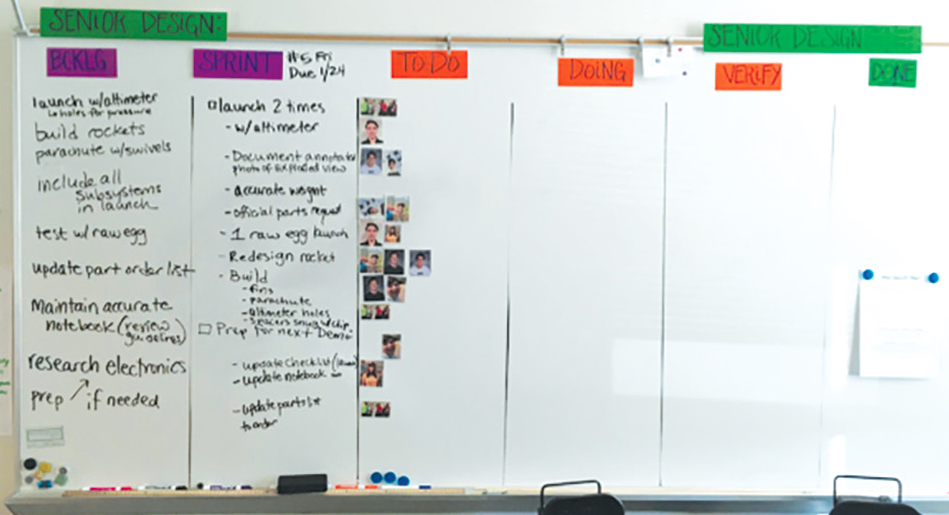feature
You Don’t Have to be a Rocket Scientist
Using a project management lens and agile methodologies to enhance student employability skills and innovation
Society values the vital role scientists and engineers play in solving urgent, real-world problems such as developing COVID-19 vaccines. The NGSS framework for Engineering Design articulates specific practices and disciplinary core ideas that work in conjunction with other science standards to equip today’s youth to be solvers of tomorrow’s problems: asking questions, defining problems, and developing and optimizing solutions (NGSS Lead States 2013).
Students learning engineering design develop the most in-demand employability skills: creativity, persuasion, collaboration, adaptability, and emotional intelligence (Pate 2020). Despite the urgency, teaching for innovation remains a challenge.
Facilitating student innovation requires persisting without an answer key and can feel unnerving. Uncertainty reduces teacher clarity, an important metric in student progress and achievement (Hattie 2012). Preparing students to solve authentic problems requires departure from backward design (Wiggins and McTighe 2005), and incorporation of new strategies to help students navigate uncertainty. This article shares classroom-tested strategies, inspired by methods used across many industries, to level-up student development of science and engineering practices and leadership.
Challenges teaching for student innovation
Throughout this yearlong, project-based, capstone course, teams grappled with solving authentic problems. Students expressed frustration with unequal workloads and idle time as they waited for peers to finish tasks prerequisite to their own. Students simply couldn’t plan for what they didn’t know. They needed better guidance to:
- deconstruct problems into specific, measurable, and achievable pieces
- prioritize tasks sequentially and take responsibility for immediately actionable tasks
- transparently report progress to one another and freely express their need for help, and
- generate testable prototypes early and often.
Fortunately, industry overcomes these same challenges.
Industry perspective
STEMpath is a graduate-level certificate program for educators that combines coursework with industry work experience. “Research shows that externships are a key differentiator in educator professional development. And when structured as an extended individualized experience, the typical results are improved teacher motivation and confidence, increased teacher commitment to teaching, enhanced teacher knowledge and abilities, and sustained changes to classroom practice” (Lauth and Risteff 2019). Especially relevant from the author’s STEMpath experience were insights about project management and a software development framework, Agile. Participating in STEMpath afforded the author the opportunity to adapt and test modern industry practices in a high school classroom.
Just as project managers lead teams to develop criteria-driven solutions for clients by a given deadline, so too are teachers project managers! Sustained changes to the author’s practice include teaching students to use agile to develop their knowledge of forces and motion within the context of a rocketry design challenge. Unlike previous capstone cohorts, the Agile team tested prototypes of their innovation early and often.
The Agile framework and classroom application
Although Agile methods maximize team efficiency and the spirit of failing fast as an industry standard, teachers are generally not formally experienced with its processes and nomenclature. Named playfully after rugby, an Agile scrum refers to, “a management framework for incremental product development using one or more cross-functional, self-organizing teams of about seven people,” (James and Walter 2010). Vocabulary includes scrum board, product backlog, product backlog item, product owner, scrum master, and sprint.
Teams compartmentalize work into two-week sprints wherein each person works urgently to accomplish tangible results. Sprints conclude with a demonstration of a working subcomponent. One student summarizes, “The scrum method effectively parses a major goal, and makes the steps needed to achieve the goal easier to see, and in turn, easier to complete” (Tyler).
A scrum board visually displays a project and progress (Figure 1). The first column in a scrum board is the product backlog, an overall project to do list containing tasks called project backlog items (PBIs). The list does not anticipate all possible tasks; instead, the product backlog dynamically presents a team’s best understanding at the time. Product backlogs inform sprint task prioritization. A student leader, called a scrum master, facilitates meetings, using a core Agile value to flatten hierarchies and promote communication. Early in the year the author intervened frequently to prompt students to become more specific, and offered specific subtasks to those in need of help.

Scrum board.
The teacher acts as the product owner and holds the responsibility of updating the product backlog. Talking through his or her thinking serves to model adaptability for students and demonstrates how to cope with uncertainty. As tasks move toward completion, the sticky note containing each PBI moves across the scrum board. Alternately, a photo of the responsible team member moves rightward along a PBIs row (Figure 2). The objective is to make progress, or lack thereof, visible.

Scrum board with student photos.
From a student perspective:
The scrum structure that Senior Design follows benefits my learning because it keeps me organized and I always know what I am working on. I also can always find something to work on if I finish something earlier than expected. The breakdown of tasks helps me to feel less intimidated by the large project that we are working on. Even though we break things into tasks that each take one person to complete, I feel like we still use a lot of collaboration and teamwork. Team members aren’t afraid to discuss ideas or ask questions in order to improve their part.” (Emily).
In 2020, transitioning to online learning necessitated a digital scrum board (Figure 3). Thankfully, many digital project management tools exist, such as Trello and Miro. The team’s Boeing mentor observed, “Familiarizing students with Agile tracking technologies would make them even more prepared for the workforce.” For more information see the Agile 101, Agile Glossary, and Rose 2015.

Digital scrum board.
Agile teams use specific meeting types, or rituals. This article shares secondary classroom applications, student perspectives, and tips for each ritual.
Sprint planning meeting
Sprints begin with a sprint planning meeting. Although the product owner (teacher) identifies the PBIs, the development team (students) selects specific PBIs to include in a sprint. Benefits of sprint planning are that each student leaves the meeting knowing what specific priorities the team is responsible to complete together. If a task is contingent on other tasks, then it waits in the product backlog until actionable.
Selected PBIs move rightward into the scrum board’s sprint task list column. Next, students estimate the relative time needed to complete each sprint task. A deck of sprint estimation cards helps engage all student voices and practice persuasion and adaptability. Each student receives a set of eight cards to vote for how long they predict each sprint task will take (Figure 4). For example, students select a card, hold it face down, then reveal their votes simultaneously. Students discuss and vote again until reaching consensus on each item. If students agree that an item will take longer than the two-week sprint, it returns to the project backlog to be subdivided.

Estimation cards.
One by one, team members commit to specific sprint task items, placing their magnetized photo to the right of each task. The public nature of this ritual helps students practice collaborative decision-making and gain the assertiveness needed to raise concerns. An important outcome of sprint planning is an equitable workload for all teammates.
From student Emily’s perspective:
I find the sprint planning meeting to be the most valuable because it gets the team to focus on the future and make sure that the project is on track for the overall timeline. It also allows the group to break down large ideas into small achievable tasks. These meetings help to make the project seem less intimidating and can give students confidence in their work.
Daily stand-up and scrum
A student scrum master facilitates the beginning of each class within a sprint with a stand-up to review the scrum board and refresh student commitments to their daily work. Standing up together motivates participants and keeps the conversation brief. Everyone answers three focus questions:
- What did I do yesterday to help meet the Sprint Goal?
- What will I do today to help meet the Sprint Goal? and
- What impediments do I have that are blocking me (or others) from meeting the Sprint Goal?
If students expect to have time remaining, they establish stretch goals. Students should only disperse from daily stand-ups when they know clearly what everyone’s next steps are. Over time the daily stand-up becomes more efficient and should be time-boxed to less than 10 minutes. Next, students jump into their daily scrum, or work time on their tasks for the majority of class time.
From student James’s perspective:
The intended goals for the day for each student are made apparent. This is valuable because other students can request help with larger or more technical tasks that may be impossible alone, and as a whole allow for students to develop as a team, while providing a high-quality product at the end of the sprint.
Student Miriam paraphrased, “[the daily stand-up] is most valuable to me, because it tells me exactly what I need to do.” Students identified the need to regroup at the end of class to update the scrum board and encourage accountability.
Sprint review
A sprint review occurs on the last day of each sprint. Developers demonstrate their work, receive feedback, and revise the product backlog. James identified a challenge:
Grading is less structured than a typical class. This is because each student has a different set of responsibilities and cannot be graded on the exact same criteria. A useful implementation to the grading system would be a clear and apparent list of what a student will be graded on, where the ‘rubric’ is flexible from sprint to sprint.
Students also reiterated a rubric with the author that encourages collaboration and reflects individual accomplishment (Figure 5).
Scrum rubrics.
Scrum meetings and sprints (5 points each)
__ Student participates actively in daily stand-up—succinct and specific contributions
__ Students participate in daily scrum board update and brief end-of-class meeting
__ Student uses all class time effectively
__ Clean-up of space is complete every day
__ Student follows through on items they say they will complete, bring in, or do from home
____/25
Demos (15 points each)
__ Student articulates each sprint goal and his/her/their progress towards it using visual aids and prototypes
__ Student completed each task, or has a clear rationale for partial completion and next steps
__ Student contributes insightful feedback during the Retrospective meeting to improve team process
__ Professional poise and public speaking strategies during demo (5 points)
____/50
Final product (25 points each)
__ Product is complete and design is well thought out and documented
__ Product functions correctly, such as qualifying launch
____/50
The author uses sprint reviews to anchor assessment of each student’s progress toward his or her goals as selected in the sprint planning meeting. Half of each student’s grade comes from these “demos,” yielding an individual grade; the other half reflects the team’s use of class time, meetings, and the final product (a shared grade). Shared grades encourage interdependence and time management. Students maintain ownership over the workflow, and the author/teacher needs not predict and backward plan each content standard. Instead, the teacher facilitates student responsiveness to their own data analysis with explanations, reiteration, and new investigations.
Sprint Retrospective
A retrospective concludes each sprint and focuses on team process, rather than product, with the goal of improving team functioning. Stating the Prime Directive is recommended at the beginning in order to set a positive tone: “Regardless of what we discover, we understand and truly believe that everyone did the best job they could, given what they knew at the time, their skills and abilities, the resources available, and the situation at hand” (Kerth 2001).
Added benefits of retrospectives include the cultivation of emotional intelligence, humility, and forthright communication. Holding retrospectives in a different location disrupts the daily routine and stimulates creativity, novelty and a lighthearted atmosphere. The author enjoys using an outdoor picnic table and the library’s collaborative space. A six-to-one ratio of positive to developmental feedback is recommended, as well as a visual deliverable. Students create a poster that lists a few successes and actionable improvements, and they hang it next to the scrum board to prompt self-regulation. Student Rithik observed that being “able to follow the same method over time allows improvement.”
Students often express the need to improve communication and identify action items such as speaking up honestly about any confusions during daily stand-ups as well as to explicitly asking quiet members to share their opinions.
Retrospective coaching cards contain reflective questions, such as “How well have you embodied your vision during this sprint?” or “In what way(s) did you contribute to your own obstacles?” Students lead a discussion about their prompt, but the tool may become unnecessary as students gain comfort with one another, As Jamis stated:
We often spend too much time on sprint retrospective meeting answering broad questions that may not apply to that sprint or may lead to repetition— it might possibly be better if this was a bit more open ended to member input, allowing the team to really ask the questions that need to be asked, and celebrate the things that went successfully.
Example project
One student team in the author’s class used Agile methods to structure their teamwork toward the American Rocketry Challenge. Engineering design (ETS) and physical science (PS) standards, science and engineering practices, and disciplinary core ideas threaded throughout student learning. All scrum rituals involved engineering and science practices of communication, and students improved with these skills most evidently in demos and retrospectives.
In the rocketry challenge, Agile methods helped students design a solution to a complex real-world problem by breaking it down into smaller, more manageable problems that can be solved through engineering (HS-ETS1-2). Rapid iteration of testable deliverables during each sprint helped students evaluate a solution to a complex real-world problem based on prioritized criteria and trade-offs that account for a range of constraints, including cost, safety, reliability, and aesthetics (HS-ETS1-3).
In the NGSS framework of three-dimensional teaching and learning, ETS standards are used along with science standard(s). Student content learning in the rocketry challenge focused primarily on forces and interactions, Newton’s laws of motion, and balanced/unbalanced forces (HS-PS2-1). Working toward qualifying for the American Rocketry Challenge generated a meaningful reason for students to learn physics, and Agile methods provided a framework to guide students toward efficient teamwork and overall productivity.
Conclusion
Teaching students to use Agile in content-rich design challenges improves student productivity, meaningful development of science and engineering practices, and disciplinary core ideas. An administrator noted, “Learning how to work within the Agile framework in high school will give these students an industry-proven tool for productivity in engineering or beyond.” Educators of any grade level may incorporate Agile vocabulary and rituals into project-based or inquiry investigations to scaffold interdependent collaboration and student leadership. ■
On The Web
Agile Manifesto: https://www.scrumalliance.org/resources/agile-manifesto
Agile Alliance Glossary: https://www.agilealliance.org/agile101/agile-glossary/
Agile101: https://www.agilealliance.org/agile101/
James, M., and L. Walter. 2010. Scrum Reference Card. https://www.collab.net/sites/default/files/uploads/CollabNet_scrumreferencecard.pdf
O’Connell, K. 2018. LinkedIn Learning Cert Prep: Scrum Master Course. https://www.linkedin.com/learning/cert-prep-scrum-master
Pate, D.L. 2020. The Skills Companies Need Most in 2020—And How to Learn Them. https://learning.linkedin.com/blog/top-skills/the-skills-companies-need-most-in-2020and-how-to-learn-them
Risteff, M. 2019. STEMpath Program Kicks Off First Summer of Externships—Welcome Kelsey! https://www.couragion.com/stem-crossings/2019/6/12/stempath-program-kicks-off-first-summer-of-externships-welcome-kelsey
Kelsey Rasmussen (kelsey.rasmussen@knowlesteachers.org) is an engineering teacher at Erie High School, Erie, CO.
Inclusion Interdisciplinary Teaching Strategies Technology



